Tracking the Fragile X Mental Retardation Protein in a Highly Ordered Neuronal RiboNucleoParticles Population: A Link between Stalled Polyribosomes and RNA Granules
- PMID: 27462983
- PMCID: PMC4963131
- DOI: 10.1371/journal.pgen.1006192
Tracking the Fragile X Mental Retardation Protein in a Highly Ordered Neuronal RiboNucleoParticles Population: A Link between Stalled Polyribosomes and RNA Granules
Abstract
Local translation at the synapse plays key roles in neuron development and activity-dependent synaptic plasticity. mRNAs are translocated from the neuronal soma to the distant synapses as compacted ribonucleoparticles referred to as RNA granules. These contain many RNA-binding proteins, including the Fragile X Mental Retardation Protein (FMRP), the absence of which results in Fragile X Syndrome, the most common inherited form of intellectual disability and the leading genetic cause of autism. Using FMRP as a tracer, we purified a specific population of RNA granules from mouse brain homogenates. Protein composition analyses revealed a strong relationship between polyribosomes and RNA granules. However, the latter have distinct architectural and structural properties, since they are detected as close compact structures as observed by electron microscopy, and converging evidence point to the possibility that these structures emerge from stalled polyribosomes. Time-lapse video microscopy indicated that single granules merge to form cargoes that are transported from the soma to distal locations. Transcriptomic analyses showed that a subset of mRNAs involved in cytoskeleton remodelling and neural development is selectively enriched in RNA granules. One third of the putative mRNA targets described for FMRP appear to be transported in granules and FMRP is more abundant in granules than in polyribosomes. This observation supports a primary role for FMRP in granules biology. Our findings open new avenues for the study of RNA granule dysfunctions in animal models of nervous system disorders, such as Fragile X syndrome.
Conflict of interest statement
The authors have declared that no competing interests exist.
Figures
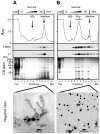



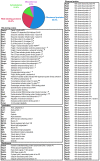
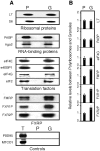
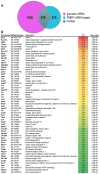

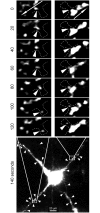
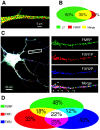

Similar articles
-
Biochemical evidence for the association of fragile X mental retardation protein with brain polyribosomal ribonucleoparticles.Proc Natl Acad Sci U S A. 2004 Sep 7;101(36):13357-62. doi: 10.1073/pnas.0405398101. Epub 2004 Aug 25. Proc Natl Acad Sci U S A. 2004. PMID: 15329415 Free PMC article.
-
mRNPs, polysomes or granules: FMRP in neuronal protein synthesis.Curr Opin Neurobiol. 2006 Jun;16(3):265-9. doi: 10.1016/j.conb.2006.05.010. Epub 2006 May 16. Curr Opin Neurobiol. 2006. PMID: 16707258 Review.
-
Fragile X mental retardation protein induces synapse loss through acute postsynaptic translational regulation.J Neurosci. 2007 Mar 21;27(12):3120-30. doi: 10.1523/JNEUROSCI.0054-07.2007. J Neurosci. 2007. PMID: 17376973 Free PMC article.
-
Metabotropic glutamate receptors and fragile x mental retardation protein: partners in translational regulation at the synapse.Sci Signal. 2008 Feb 5;1(5):pe6. doi: 10.1126/stke.15pe6. Sci Signal. 2008. PMID: 18272470 Review.
-
Absence of the Fragile X Mental Retardation Protein results in defects of RNA editing of neuronal mRNAs in mouse.RNA Biol. 2017 Nov 2;14(11):1580-1591. doi: 10.1080/15476286.2017.1338232. Epub 2017 Sep 5. RNA Biol. 2017. PMID: 28640668 Free PMC article.
Cited by
-
Tyramine induces dynamic RNP granule remodeling and translation activation in the Drosophila brain.Elife. 2021 Apr 23;10:e65742. doi: 10.7554/eLife.65742. Elife. 2021. PMID: 33890854 Free PMC article.
-
Formation, function, and pathology of RNP granules.Cell. 2023 Oct 26;186(22):4737-4756. doi: 10.1016/j.cell.2023.09.006. Cell. 2023. PMID: 37890457 Free PMC article. Review.
-
Construction destruction: Contribution of dyregulated proteostasis to neurodevelopmental disorders.Curr Opin Neurobiol. 2025 Feb;90:102934. doi: 10.1016/j.conb.2024.102934. Epub 2024 Nov 28. Curr Opin Neurobiol. 2025. PMID: 39612590 Review.
-
Cataloguing and Selection of mRNAs Localized to Dendrites in Neurons and Regulated by RNA-Binding Proteins in RNA Granules.Biomolecules. 2020 Jan 22;10(2):167. doi: 10.3390/biom10020167. Biomolecules. 2020. PMID: 31978946 Free PMC article. Review.
-
The translational regulator FMRP controls lipid and glucose metabolism in mice and humans.Mol Metab. 2019 Mar;21:22-35. doi: 10.1016/j.molmet.2019.01.002. Epub 2019 Jan 14. Mol Metab. 2019. PMID: 30686771 Free PMC article.
References
-
- Ramón y Cajal S. 1894. The Croonian lecture: la fine structure des centres nerveux. Proceedings of the Royal Society of London 55: 444–468.
-
- Abbott LF, Nelson SB. 2000. Synaptic plasticity: taming the beast. Nat Neurosci 3: 1178–1183. - PubMed
-
- Sutton MA, Schuman EM. 2006. Dendritic protein synthesis, synaptic plasticity, and memory. Cell 127: 49–58. - PubMed
-
- Citri A, Malenka RC. 2008. Synaptic plasticity: multiple forms, functions, and mechanisms. Neuropsychopharmacol 33: 18–41. - PubMed
Publication types
MeSH terms
Substances
LinkOut - more resources
Full Text Sources
Other Literature Sources
Medical
Molecular Biology Databases

